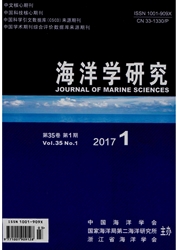

 中文摘要:
中文摘要:
文章对比分析了珠江口和北部湾海域附近沉积物重金属元素Zn、Pb、Cu、Cr和沉积物粒度之间的相关性,用沉积物富集系数法和潜在生态危害指数法对两个海域海底沉积物的4种重金属元素污染程度和生态风险进行了评价。结果表明,在黏土和粉砂沉积物中重金属富集程度大。Cu在两个区域均达严重污染程度,Zn、Pb、Cr在珠江口沿岸均达到中等污染程度,在北部湾部分区域达到中等污染程度。珠江口的潜在生态风险等级由低级到高级不等,北部湾生态风险等级均为低级。
 英文摘要:
英文摘要:
This study analyzes the heavy metals in the sediments, including Zn, Pb, Cu, Cr, and sediment grain size. It evaluates the degree of pollution and ecological risks of the four heavy metals in the Pearl River Delta and the Beibu Gulf using sediment accumulation coefficient method and HàKANSON L potential ecological hazard index method. We compare the results between the Pearl River Delta and the Beibu Gulf. The comparison shows that the clay and silt enrichment of heavy metals in sediment is large; Cu in the two regions reached the serious level of pollution, Zn, Pb and Cr reached the middle level of pollution in the Pearl River estuary and in part of the Beibu Gulf. The potential ecological risks in the Pearl River estuary range from lower to higher level, and those in the Beibu Gulf are lower. The Pearl River estuary has been severely damaged due to human activities, and the Beibu Gulf, as a national development site, should receive priority to prevent pollutions, and adapt policies to develop and protect the natural environment.
 同期刊论文项目
同期刊论文项目
 同项目期刊论文
同项目期刊论文
 期刊信息
期刊信息
